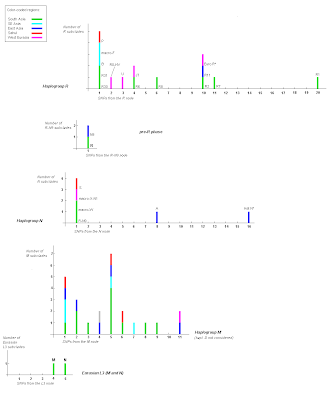In the previous post I explored the apparent pulses of the expansion of mtDNA macro-haplogroup M. Then I considered that the same method could be extended to all Eurasian mtDNA. Here I post a graph that does precisely that with the three so-called Eurasian macrohaplogroups: M, N and R (this last a descendant of N but most important on its own right):
 click to expand
click to expand(for detail on M subclades see previous post)
What do I see here?
Haplogroup N:
N participated in the expansion of M along the Indo-Pacific arc as "young sister", so to say. N shows a slightly (1 SNP) longer coalescence than M and that explains well why in the first moment M almost monopolized the show - it's still today much more important in numbers and diversity than N(xR).
Nevertheless N seems to have sent an avanguard descendant towards the West within that process: macro-X-N1, maybe with its "sister" W (?). This is a niche that M does not seem to have explored until very late, maybe because of geographic constrictions.
Haplogroup R:
R seems to have participated very actively in the onset of the second pulse of M expansion, also following mainly the route eastward (from South Asia), where it found a niche (B and F especially). But within this second eastern expansion, or just in the aftermath, R descendants (R0-HV, U and JT) begin pouring into West Eurasia, following the trail of macro-X-N1.
Sahul:
Most of the haplogroups found in Australia (aborigines) and New Guinea split within the two expansive pulses, meaning that they did so after arrival to Sahul. The colonization of this continent took place together with the main colonization of Eastern Asia (and largely that of South Asia itself).
S (Australian clade) and M27-29 (Melanesian) appear to belong to the earliest pulse, while P, Q, and M42 rather seem to belong to the second pulse. There are also some other derived clades (N* within macro-W, some R31 subclades) that appear to have arrived to Australia from South Asia but I'm not considering here.
Late localized pulses:
Surely there are others within derived clades that I have not considered so far. But, within these three macro-haplogroups, A (East Asia and America) and M6 (South Asia) seem to have expanded rather late. Even later than these would be the expansion of M1 in westward direction.
Chronological approximation:
If the H node (not shown but placed 5 SNPs away from R) corresonds with Aurignacian expansion, then it approximates 45-40,000 years BP. If the M node corresponds with the Toba epysode, then it must be some 74,000 years old. Therefore each new SNP can approximate some 4,000 years of perehistory.
The first expansive pulse, therefore would have happened some 4000-8000 years after Toba, that is c. 70-66,000 BP. The second expansive pulse would have taken place instead more around 55,000 BP.
Just a very rought estimate, I know, but please don't begin telling me that two similarly derived subclades may have evolved in totally different periods. That is blatant nonsense, even if hidden behind erudite equations.
And when out of Africa then? Well, if the above estimate has any value, and as the number of SNPs separating M from L3 is of 4: 4000x4=16000, 16000+74000= 90000 BP or, roughly, when the Aterian people were in North Africa and their close relatives in the Levant.
Rough but efefctive it seems. I'm open to fine-tuning suggestions.
.










No comments:
Post a Comment